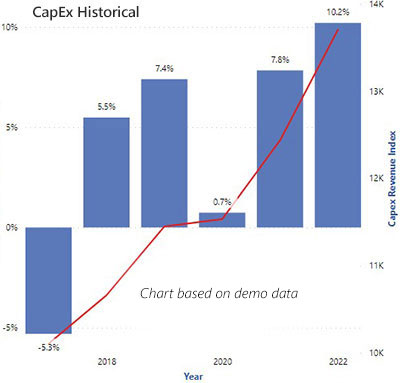According to recent ARC Advisory Group research, the Human-Machine Interface (HMI) software and services market is poised for significant growth, driven by key industry trends. In the automotive sector, the rise of electric vehicle (EV) and battery manufacturing demands advanced HMI capabilities for efficient production processes. Sustainability and circularity initiatives in the food and beverage and consumer packaged goods (CPG) industries emphasize the need for HMI solutions that support eco-friendly practices. Additionally, energy optimization remains a top priority across manufacturing sectors, driving the demand for HMI software that can enhance operational efficiency. These drivers underscore the importance of robust and adaptable HMI software solutions in meeting the evolving needs of diverse industries. The global HMI software and services market is undergoing a transformative phase, driven by Industry 4.0's technological advancements. HMI software acts as a crucial bridge between humans and machines in various industries. It enables seamless communication, improves productivity, and enhances safety. Key trends include Industry 4.0 adoption, advanced visualization tools, remote monitoring capabilities, integration of AI and machine learning, cloud integration, cybersecurity measures, and a focus on sustainability. HMI software‘s future holds promise, with innovations like augmented reality interfaces and edge computing integration.
"The evolution of HMI from a traditional machine control function to a central visualization unit is a pivotal driver for the growth of the HMI software market. Modern HMIs are expected to display not only control data but also environmental information, MES (Manufacturing Execution System) data, and historical data. This expanded role transforms HMIs into comprehensive tools for operators, providing a holistic view of operations. Vendors capable of meeting these evolving demands are in a prime position for growth. Their ability to provide integrated solutions that bridge the gap between machine control and data visualization positions them at the forefront of an industry poised for significant expansion,” according to Siddhartha Maiti, Senior Analyst and key author of ARC's Human-Machine Interface Software & Services Market Research.
Human-Machine Interface Market Trends
In addition to providing detailed competitive market share data, the research also addresses key market trends as follows:
- Multi-touch Screen
- Industrial IoT and Industry 4.0
- Virtual Deployment will Greatly Improve Software Management
- Collaborative Visualization Tools
- More Analytics
- Subscription Service as a Business Model
- Impact of AR and VR on HMI/SCADA Software
- AI at Edge
- Sustainability and Energy Optimization for EV and CPG/Food & Beverage Industries
- OT-IT Integration
- Transition Toward Thin Clients
- Wider Adoption of Mobile and Handheld Devices
- Evolution of HMI Software from EOI Panels to Versatile Visualization Solutions
- Rising Adoption of Off-Premises Cloud Computing in the HMI Software Market
- Data Democratization Will Be Driven by AI
- Windows 11 and Server 2022
- Cloud and Edge System Virtualization
- Rising Linux Adoption Driven by Containerization Trends
- OPC-UA
Leading Suppliers to the Human-Machine Interface Software Market Identified
In addition to providing specific market data and industry trends, this ARC market research also identifies and positions the leading suppliers to this market and provides and summarizes their relevant offerings. An alphabetical list of key suppliers covered in this analysis includes: AVEVA, General Electric, Inductive Automation, Rockwell Automation, Siemens.
About the Human-Machine Interface Research
 The Human-Machine Interface Software research explores the current and future market performance and related technology and business trends and identifies leading technology suppliers. This new research is based on ARC’s industry-leading market research database, extensive primary and secondary research, and proprietary economic modelling techniques. The research includes competitive analysis, five-year market forecasts, and five years of historical analysis. The research segmentation includes Machinery by Segment, Industry, Customer Type, World Region, Sales Channel, Service Revenues by Type, Deployment Model, Revenue Category, Software Revenues by Type, Microsoft Operating Systems, Operating Systems, Software Revenues By Microsoft Operating System, Software Revenues By Operating System, Overall Scope.
The Human-Machine Interface Software research explores the current and future market performance and related technology and business trends and identifies leading technology suppliers. This new research is based on ARC’s industry-leading market research database, extensive primary and secondary research, and proprietary economic modelling techniques. The research includes competitive analysis, five-year market forecasts, and five years of historical analysis. The research segmentation includes Machinery by Segment, Industry, Customer Type, World Region, Sales Channel, Service Revenues by Type, Deployment Model, Revenue Category, Software Revenues by Type, Microsoft Operating Systems, Operating Systems, Software Revenues By Microsoft Operating System, Software Revenues By Operating System, Overall Scope.
This new research is available in a variety of formats to meet the specific research and budgetary requirements of a wide variety of organizations. ARC's Market Data Service (MDS) is an annual subscription service that provides a unique online environment to each customer, together with all the necessary user interface apps and datasets. MDS unlocks the full benefits of ARC’s time-tested market intelligence by leveraging the latest analytical tools and technologies to allow you to make more actionable, real-time business decisions. Interactive access to ARC’s qualitative analysis is displayed in context with up-to-date market data, allowing clients to develop customized views of the market to best suit their needs. ARC continues to offer our traditional static Market Reports as a PDF.
ARC provides several types of market data services. The most common are Market Growth Outlook and Competitive Analysis Services. These services provide detailed market analysis of a single or multiple products or software applications. Please visit Market Data Services page for more details on these services.
